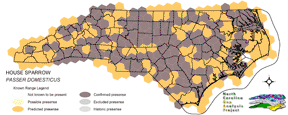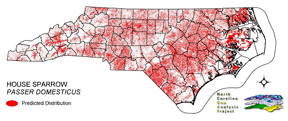
| Taxa: |
| Order: |
| Family: |
| Aves |
| Passeriformes |
| Passeridae |
| NatureServe Global Rank: |
| NatureServe State (NC) Rank: |
| G5 |
| SE |
| Federal Status: |
| NC State Status: |
| --- |
| --- |


| Land Unit |
| US Fish & Wildlife Service |
| US Forest Service |
| US National Park Service |
| US Department of Defense |
| NC State Parks |
| NC University System |
| NC Wildlife Res. Com. |
| NC Forest Service |
| NC Div. of Coastal Mgmt. |
| Local Governments |
| Non-Governmental Org. |
| Other Public Lands |
| Private Lands |
| GAP Status 1-2 |
| All Protected Lands |
| Statewide |
| Hectares |
| 6,731.10 |
| 11,502.09 |
| 15,717.42 |
| 2,895.93 |
| 1,552.86 |
| 1,214.37 |
| 4,952.79 |
| 976.65 |
| 34.74 |
| 652.14 |
| 1,602.54 |
| 2,462.85 |
| 3,923,336.43 |
| 15,432.36 |
| 48,950.52 |
| 3,973,631.91 |
| Acres |
| 16,632.91 |
| 28,422.28 |
| 38,838.58 |
| 7,156.00 |
| 3,837.20 |
| 3,000.77 |
| 12,238.61 |
| 2,689.87 |
| 85.84 |
| 1,611.47 |
| 3,959.96 |
| 6,085.83 |
| 9,694,773.56 |
| 38,410.70 |
| 121,235.86 |
| 9,819,332.89 |
| % of Dist. on |
| Prot. Lands |
| 13.8 % |
| 23.5 % |
| 31.9 % |
| 5.9 % |
| 3.2 % |
| 2.5 % |
| 9.1 % |
| 2.0 % |
| < 0.1 % |
| 3.1 % |
| 3.1 % |
| 3.8 % |
| < 0.1 % |
| 31.5 % |
| ----- |
| ----- |
| % of Dist. on |
| All Lands |
| 0.2 % |
| 0.3 % |
| 0.4 % |
| < 0.1 % |
| < 0.1 % |
| < 0.1 % |
| 0.1 % |
| < 0.1 % |
| < 0.1 % |
| < 0.1 % |
| < 0.1 % |
| < 0.1 % |
| 98.7 % |
| 0.4 % |
| ----- |
| ----- |
|
Introduced. Fairly common to abundant across the state (Fussell and Lyons 1990, Potter et al. 1980). Always associated with humans and never found in a habitat unaltered by human activity. Found in a wide variety of areas such as cities, suburbs, farms (Kaufman 1996), and woodland edges near human habitation. Found especially around horses (Ehrlich et al. 1988). Prefers to nest in a cavity such as a natural cavity in a tree, an abandoned woodpecker hole, a birdhouse, a hole in a wall, under the eaves of a building, behind a wall-mounted sign, or in the nest of a Cliff or Barn Swallow (Nicholson 1997). Can be an aggressive competitor with native species for cavities, sometimes ejecting eggs or young. If a cavity is not available, will build a nest in the fork of a tree branch up to 40 feet above the ground. Forages primarily on the ground (Ehrlich et al. 1988) but is an opportunistic feeder; will frequent bird feeders and pick insects from the grill of cars (Kaufman 1996). NATURE SERVE GLOBAL HABITAT COMMENTS: North America: cities, villages, farms, parks. Nests in cavities and in crevices of structures. |
| Code | Name | Description | NC Natural Heritage Program Equivalent |
| 180 | Agricultural Crop Fields | Farm fields used for row crops. | No equivalent |
| 205 | Agricultural Pasture/Hay and Natural Herbaceous | Farm fields used for pasture grass or hay production, as well as old fields dominated by native and exotic grasses. | No equivalent |
| 202 | Residential Urban | Includes vegetation interspersed in residential areas. Includes lawns, mixed species woodlots, and horticultural shrubs. Vegetation accounts for between 20 - 70% of the cover. | No equivalent |
| 203 | Urban Low-Intensity Developed | Highly developed areas with vegetation accounting for < 20% of the cover. | No equivalent |
| 204 | Urban High-Intensity Developed and Transportation Corridors | Highly developed areas including infrastructure such as roads, railroads. Vegetation represents < 20% of the cover. | No equivalent |
|
Aguero, D. A., R. J. Johnson, and K. M. Eskridge. 1991. Monofilament lines repel house sparrows from feeding sites. Wildl. Soc. Bull. 19:416-422.
Pochop, P. A., R. J. Johnson, and K. M. Eskridge. 1993. House sparrow response to monofilament lines at nest boxes and adjacent feeding sites. Wilson Bull. 105:504-513. Anderson, T. R. 1994. Breeding biology of house sparrows in northern lower Michigan. Wilson Bull. 106:537-548. Fussell, J. III and M. Lyons. 1990. Birds of the Outer Banks [pamphlet]. Eastern National Parks and Monument Association Coastal Wildlife Refuge Society. Kaufman K. 1996. Lives of North American Birds. Boston, New York: Houghton Mifflin Company. Nicholson CP. 1997. Atlas of the breeding birds of Tennessee. Knoxville: University of Tennessee Press. Bennett, W. A. 1990. Scale of investigation and the detection of competition:an example from the house sparrow and house finch introductions in North America. Am. Nat. 135:725-747. Summers-Smith, D. 1963. The house sparrow. London. xvi + 269 pp. Bent, A. C. 1968. Life histories of North American cardinals, grosbeaks, buntings, towhees, finches, sparrows, and allies. Bull. U.S. Nat. Mus. 237. Kendeigh, S.C. 1973. Symposium on house sparrow and European tree sparrow. Lawrence. 127 pp. Harrison, C. 1978. A field guide to the nests, eggs and nestlings of North American birds. Collins, Cleveland, Ohio. Harrison, H.H. 1979. A field guide to western birds' nests. Houghton Mifflin Company, Boston. 279 pp. Potter, E. F., J. F. Parnell, and R. P. Teulings. 1980. Birds of the Carolinas. Univ. North Carolina Press, Chapel Hill. 408 pp. Terres, J.K. 1980. The Audubon Society encyclopedia of North American birds. Alfred A. Knopf, New York. American Ornithologists' Union (AOU), Committee on Classification and Nomenclature. 1983. Check-list of North American Birds. Sixth Edition. American Ornithologists' Union, Allen Press, Inc., Lawrence, Kansas. Raffaele, H.A. 1983. A guide to the birds of Puerto Rico and the Virgin Islands. Fondo Educativo Interamericano, San Juan, Puerto Rico. 255 pp. Pratt, H.D., P.L. Bruner, and D.G. Berrett. 1987. A field guide to the birds of Hawaii and the tropical Pacific. Princeton University Press, Princeton, New Jersey. 409 pp. + 45 plates. Ehrlich, P.R., D.S. Dobkin, and D. Wheye. 1988. The birder's handbook:a field guide to the natural history of North American birds. Simon and Shuster, Inc., New York. xxx + 785 pp. Summers-Smith, J. D. 1988. The sparrows. Poyser. 352 pp. Barrows, W. B. 1889. The English sparrow (PASSER DOMESTICUS) in North America. USDA, Div. of Economic Ornithology and Mammalogy, Bull. 1. 405 pp. Raffaele, H.A. 1989. A guide to the birds of Puerto Rico and the Virgin Islands. Revised edition. Princeton Univ. Press. 220 pp. Ridgely, R.S., and G. Tudor. 1989. The birds of South America. Vol. 1. The Oscine passerines. Univ. Texas Press, Austin. 516 pp. Barlow, J.C. 1973. Status of the North American population of the European tree sparrow. In a symposium on the house sparrow (PASSER DOMESTICUS) in North America. Amer. Ornith. Union, Monog. No. 14. |
For more information please contact them at:
NC-GAP Analysis Project
Dept. of Zoology, NCSU
Campus Box 7617
Raleigh, NC 27695-7617
(919) 513-2853